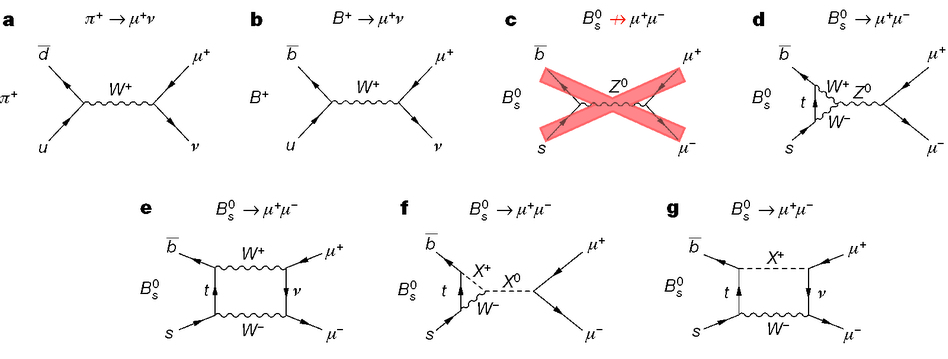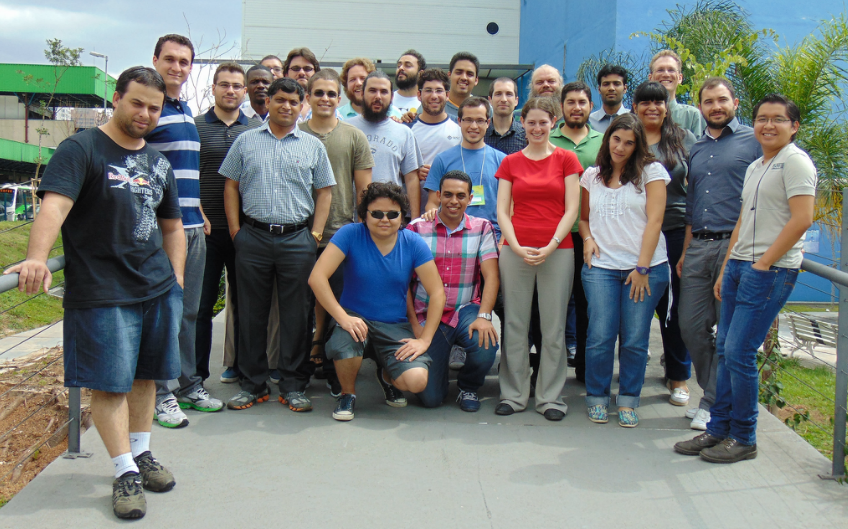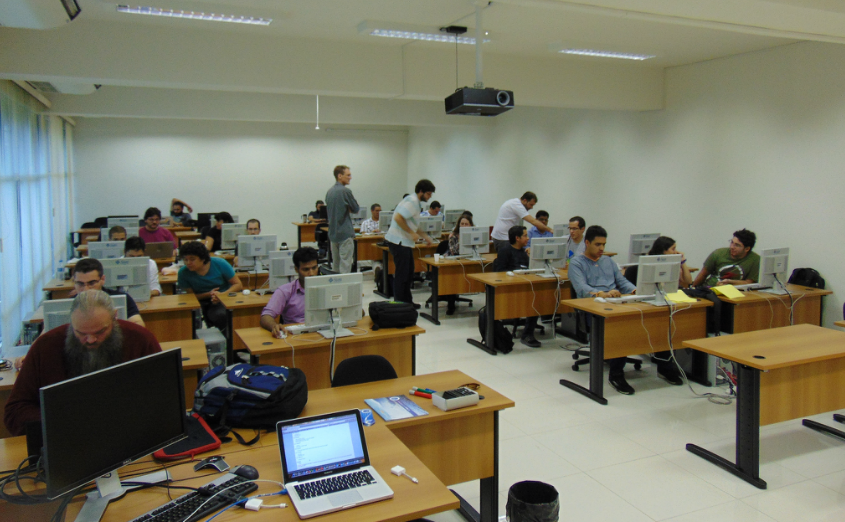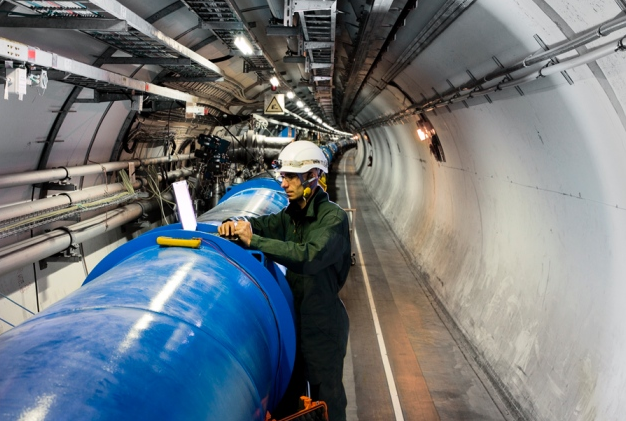LHC observes rare decays with high precision for the first time
Scientists at the Large Hadron Collider (LHC) announced this month the observation, with high precision, of an extremely rare phenomenon: the decay of mesons B0s and B0 into two muons. These mesons can decay in several different ways, and the probabilities of these specific decays are of about 1 per each 250 million B0s mesons produced and of 1 per each 10 billion B0 mesons. Data analysis was made by researchers from CMS (Compact Muon Solenoid) and LHCb (Large Hadron Collider beauty), and included the participation of the São Paulo Research Analysis Center (SPRACE), which is part of the CMS collaboration.
Read the article, published in Nature, by clicking here.
“This was the first time we observed these decays with a statistical significance higher than 6 Sigma, which means that there is only one chance in one billion of the result not being real”, explains Sérgio Novaes, SPRACE coordinator. “This observation is in agreement with Standard Model predictions and is important because it can help to rule out or restrict models beyond the Standard Model which predict different decay rates”.
The observations were made in 2011 and 2012, during the first phase of LHC experiments. This year the accelerator was turned on again for a second phase and should begin data collection in the next few months, this time with an energy of 13 TeV – an increase of 5 TeV with respect to the maximum energy of the first phase.
“With higher energies and luminosities, we will be able to make even more precise measurements,” says Novaes. “The LHC will search for new particles and will test until which point the Standard Model remains valid”.
Beyond the Standard Model
“The Standard Model cannot explain everything,” says Eduardo Pontón, ICTP-SAIFR researcher. “We don’t know, for instance, what dark matter consistes of or why there is an imbalance in the ratio between matter and anti-matter in the composition of our universe. Observations like this one made in the LHC help to establish new boundaries for the Standard Model and new limits for theories that go beyond it and try to explain these phenomena”.
One of Pontón’s research interests is in Composite Higgs Models. According to these theories, the Higgs boson is not an elementary particle – it is composed of other sub-particles. “The Higgs is the only potentially elementary particle observed in nature, to date, that has spin 0, which introduces a fine-tuning problem” he says. “Composite Higgs Models help to explain this issue, among others.”
In addition to further study the properties of the Higgs boson, searching for new particles and for observations that diverge from the Standard Model predictions are among the objectives of this second phase of LHC experiments. SPRACE will not only continue to participate in data analysis and storage, but will also try to increase its role in the CMS collaboration.
“We are starting an instrumentation project to improve detectors used by CMS,” says Novaes. “In the past, we couldn’t observe certain phenomena because we had no sufficiently powerful equipments. Now we have the LHC running at energies that allows us to study phenomena in increasingly greater scales. We face the great challenge of exploring the unknown”.
Continue Reading | Comments Off on LHC observes rare decays with high precision for the first time
ICTP-SAIFR honors Isaias Raw
Last Friday the Institute inaugurated a Chair dedicated to the researcher who created the first science kits in Brazil and turned the Butantan Institute into the country’s largest vaccine producer
Isaias Raw is not a physicist. However, he was honored with the name of a Chair in ICTP-SAIFR last Friday. The event reflected one of the most striking aspects of Raw’s brilliant career: in his own words, “I like to meddle in everything that doesn’t concern me”.
The new Chair is the result of a private donation by Gilberto Mautner, nephew of Isaias Raw, who decided to honor his uncle. The donation will partially finance a new professor at ICTP-SAIFR, that will hold the Isaias Raw Chair.
The main similarity between Raw and ICTP-SAIFR is perhaps the initiative to set up research centers in Brazil with world-class standards. Raw’s many initiatives include the creation of the first science kits in Brazil, when he directed the Brazilian Foundation for Science Education Development (Funbec). Raw also founded the publishing houses of the University of São Paulo (USP) and the University of Brasilia (UnB), created the Carlos Chagas Foundation and the Experimental Course of Medicine of USP and, along with Professor Walter Leser, unified the entrance examinations of São Paulo state universities.
In addition, he was director of the Butantan Institute and a major contributor in turning it into the first vaccines production center in the country. His career was recognized with the award of Comendador da Ordem Nacional do Mérito, in 1995, with the Grã-Cruz da Ordem Nacional do Mérito Científico, in 2001, and the Conrado Wessel Award for Science and Culture in 2005.
Watch Prof. Isaias Raw’s lecture
All this despite being arrested and having his rights revoked during the military regime in Brazil. “They thought I was a communist spy,” he joked. “At that time, it was very easy to eliminate someone who was competing with you. It was enough to accuse him of being a communist. That’s what happened to me”.
With humor and honesty, Raw spoke during the event about his life and career, and discussed the current situation of brazilian universities…
“There is a disconnection between university and society. One of the reasons why Brazil does not evolve is because universities often mistake innovation with article publication”.
education…
“If an experiment can’t go wrong, there is no reason to do it. Only when it goes wrong the student tries to figure out what went wrong and learns something new. The important thing is not the experiment itself, the important thing is that students draw their own conclusions and learn”.
and about political and economical aspects of Brazil…
“We are in a big country that attracts international interest. However, we are selling everything. We are lacking administrative competence”.
For these and other reflections the lecture of Isaias Raw deserves to be seen by students and professors, scientists and non-scientists. Raw may not be a theoretical physicist, but ICTP-SAIFR’s tribute could not be more deserved.
Continue Reading | Comments Off on ICTP-SAIFR honors Isaias Raw
ICTP-SAIFR organizes event on Scientific Computing
Workshop and course discussed the development of softwares for scientific research in different areas
The ICTP-SAIFR held, between the 13th and 30th of April, an external event of ICTP-Trieste dedicated to advanced techniques in scientific computing. During this period, there was a two-week workshop aimed at researchers of different areas and a one-week course dedicated to Particle Physics. The event was organized with the Scientific Computing Center (NCC) of Unesp and included the presence of international speakers, such as Ivan Girotto from the ICTP-Trieste.
“One of our main objectives was to improve the understanding of software development for science,” says Girotto. “We wanted to spread the knowledge we have, especially with young researchers, as scientific computing is becoming increasingly important and is currently applied in different areas of science.”
Workshop
The workshop was aimed at scientists of different fields who use scientific computing techniques in their research. Among the main examples of applications are the development of climate models and models in Biophysics and Particle Physics. The event had both theoretical lectures and practical classes, in which participants developed projects to apply the knowledge acquired throughout the course.
“Over the first two weeks, we tried to teach the participants the fundamental concepts of scientific programming using, among other tools, the Python programming language,” explains Gabriel von Winckler, one of the organizers of the event from the NCC. “Our goal was to enable them to build scientific applications using this language.”
Furthermore, the Workshop also stimulated cooperation between universities and researchers from different countries. The event has had two editions held in ICTP-Trieste and proved fruitful to encourage new partnerships and ideas.
“The participants continued to collaborate and work together on projects after the end of the events,” says Girotto. “The first edition of the workshop led to the creation of an independent event related to electronic structures, for example.”
Particle Physics
The course that followed the two-week workshop was dedicated to the application of scientific computing in Particle Physics. In this area, high performance computing is essential to simulate complex particle collisions made in large accelerators, and also to process all the information generated by the experiments. Part of the processing of the LHC data, the largest particle accelerator in the world which was recently reactivated, is done at SPRACE, a computing structure located in NCC.
Continue Reading | Comments Off on ICTP-SAIFR organizes event on Scientific Computing
LHC restarts after two years
The world’s largest particle accelerator was turned on in April and is expected to start collecting data in June
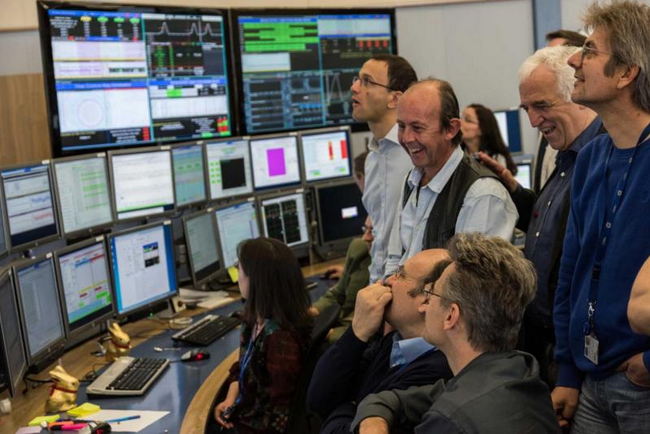
LHC operators confirm the first circulation of beams in the accelerator after two years (Image: Maximilien Brice/CERN)
The Large Hadron Collider (LHC), the largest particle accelerator in the world, was turned on again this month after a two-year period of maintenance and upgrades. Although not yet ready to make collisions, on the 5th of April two proton beams circulated in the equipment with relative low energy. Data collection is expected to homework writing begin in June, with an energy of 13 TeV – which would increase the LHC’s own record of 8 TeV.
Among the main objectives of the researchers for this second run is to further study the Higgs Boson and to discover new particles that are not predicted by the Standard Model.
Higgs Boson
In the first run of the accelerator the Higgs boson was discovered – it was the last particle of the Standard Model that had not been detected yet. Its mass was calculated with good precision: 125 GeV with an error of 0.21 for more or less. However, there is still much to learn about this particle.
“The LHC will try to make more precise measurements of the Higgs Boson properties look here http://samedayessays.org/buy-essay/and how it interacts with other particles,” says Gero von Gersdorff, postdoctoral at ICTP-SAIFR. “The way it decays, for example, can provide more information. Furthermore, a great problem in particle physics is why the mass of the Higgs is so small. Many physicists expect that this should be explained by a theory beyond the Standard Model”.
Beyond the Standard Model
With the Standard Model complete, any new particle that is discovered will require an extension of the model. Among the most studied theories that propose such extensions are Supersymmetry and the Composite Higgs models. In Supersymmetry, all Standard Model particles have a partner particle with the same physical properties, but with different spin. In Composite Higgs models, the Higgs Boson is not a fundamental particle, that is, it consists of other sub-particles. With higher energies, the LHC will be able to detect particles with larger masses and provide the first experimental evidence for these theories.
“The supersymmetric particles that are theoretically easier to detect are the squarks and gluinos, supersymmetric partners of quarks and gluons, respectively,” says Alberto Tonero, postdoctoral at ICTP-SAIFR. “In fact, the detection of these particles was expected in the first LHC run. That means that in the current model the supersymmetry wouldn’t be exact for paper editing writing, as the particles that we are looking for would have a bigger mass. If they are detected now and their supersymmetric nature is confirmed, although it will not prove Supersymmetry, it will be a strong evidence that it is correct.”
The second phase of LHC experiments will be held until 2018, when the accelerator will be turned off again. A third phase is already confirmed and should start in 2020 or 2021.
Continue Reading | Comments Off on LHC restarts after two years

